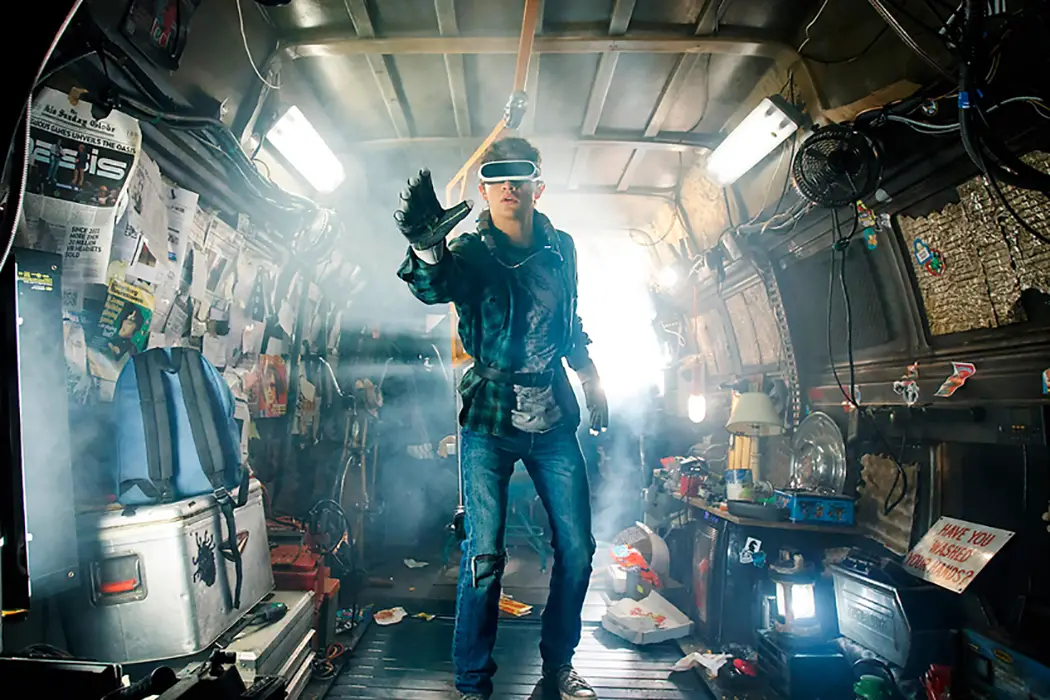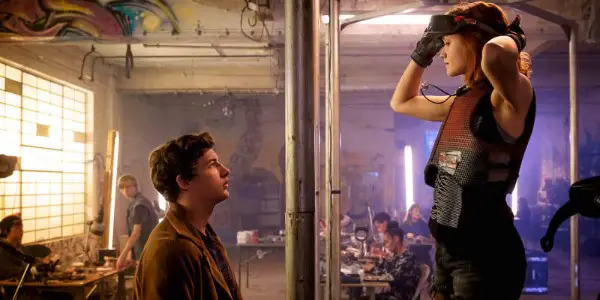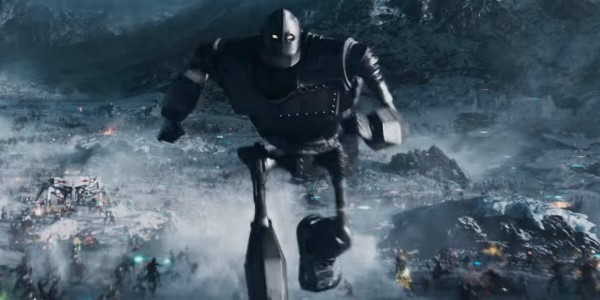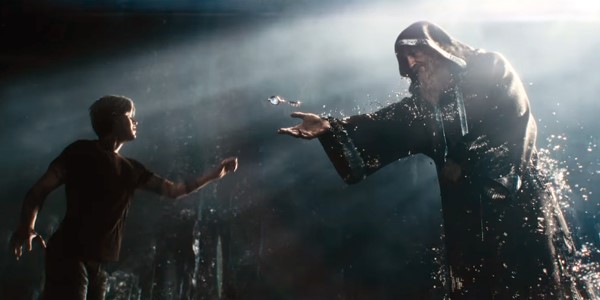READY PLAYER ONE: Spielberg’s Exhilarating Tribute To Pop Culture In 3D

Musanna Ahmed is a freelance film critic writing for Film…
Whilst Tomb Raider fails to break the unfortunate streak of bad videogame adaptations, Ready Player One is the latest entry in a cool canon of flicks that includes Scott Pilgrim vs. the World and Wreck-It Ralph – awesome videogame movies that aren’t based on any actual game.
The basis for Ready Player One is Ernest Cline‘s bestselling novel of the same name. The exciting (albeit wafer-thin) plot takes place in the not-too-distant future where a virtual reality game called the OASIS has sucked in the planet’s attention. In the OASIS you can be whoever you want to be and live any life you desire. It’s inhabited by every imaginable facet of popular culture you can think of, from the Millennium Falcon, to Monty Python, to Mortal Kombat and beyond.
An appealing escapist fantasy
It’s a world with unlimited potential so it’s understandable why it captured the imagination of so many readers, and the great Steven Spielberg has brought it to life in gleeful fashion – there are so many characters, vehicles and other familiar icons we know and love in each scene of the movie that it’s going to take multiple re-watches to spot them all.
The creator of the OASIS, James Halliday (Mark Rylance), is an eccentric genius billionaire worshipped in a cult-ish way, akin to real-life gaming tech entrepreneur Gabe Newell, but to a magnified level once he dies due to the challenge he issues to all users of the OASIS. In a posthumously released video, Halliday initiates a quest for everyone to find three keys, the Easter Eggs of his game, which will reward the winner with complete control over the software and a trillion-dollar inheritance.

The clues to finding the keys require knowledge of the creator’s persona and preferences: his favourite books, films, music and games plus the key aspects of his personal life including important friendships, relationships and his childhood. We follow one youngster, Wade Watts aka his in-game name Parzival (Tye Sheridan), who’s obsessed by Halliday more than most.
The movie counterpart of Wade is less grating than the one in the book particularly because the narration is reduced to the opening and closing of the film, helpfully avoiding some of the cringe-inducing passages like when he holds a real gun for the first time and claims it feels familiar, and a confrontation with minor antagonist I-R0k that reads like the author’s staircase wit/wish fulfillment fantasy of embarrassing a bully.
I-R0k, though, is another character improved from the source material because he gets to play a much bigger role in the movie, as the underling of the primary antagonist Nolan Sorrento (Ben Mendelsohn). We never see the human player controlling I-R0k but TJ Miller voices him in an amusing, deadpan performance that’s enhanced by the character’s wickedly baleful look and the juxtaposition of his voice with that appearance. Miller delivers the comical lines so naturally that it sounds as if the dialogue for the character was either written by the comedian or written for him and nobody else.
The major players
Mendelsohn reinforces why he’s currently Hollywood’s most sought-after villain as Sorrento, a power-hungry corporate cliché with an army of Halliday experts and physically fit players assisting him on his attempt to take down his binary opposite, Wade, the persistent kid from the downtrodden Stacks (this dystopia’s equivalent of slums) who genuinely loves pop culture. The other main characters are Aetch (Lena Waithe), Wade’s best friend and quest partner in the virtual universe, and Samantha Cook aka Art3mis (Olivia Cooke), another heavily persistent player who looks to beat Wade for the grand prize until Sorrento proves to be the bigger threat for both.
Olivia Cooke, whose been on the verge of a huge mainstream breakthrough after a string of fine performances (Bates Motel, Me and Earl and the Dying Girl, Thoroughbreds), gets her shot in this blockbuster and whilst neither her Art3mis or Sheridan’s Wade are the most compelling individuals, it’s the relationship between the two that makes them engaging. The two amiable actors have a bona fide chemistry so it’s easy to root for the pair to stop the corporate exploitation of this gargantuan thing that they cherish. This especially applies to Wade since the OASIS provides him with the escape from his life in the miserable Stacks, and now there’s a shot for him to have a considerably better standard of living with the amount of money to be won.

Halliday’s formative years were the ’80s, particularly for his taste in books, films, music and games. The decade was heavily represented in the book with references to Max Headroom, WarGames, John Hughes, etc. There’s been such an abundance of recent media that’s been influenced by or steeped in nostalgia for that era including Stranger Things, endless reboots of hit films, the revival of synth-pop, and even Cline’s own novel, so the movie Ready Player One is either perfectly timed or already outdated due to the saturation of ’80s pop culture.
Spielberg sidesteps drenching the adaptation with mostly ’80s stuff by including distinctive references to properties such as Halo, King Kong and The Iron Giant (who is especially important to the film) and cutting down on some of the ones in the novel such as the aforementioned Max Headroom and WarGames. However, there is a reference to a certain ’80s movie that’s very important to the film’s narrative – and not in the book – that results in the most uproarious sequence of the movie. A wildly popular horror flick (no spoilers), general audiences should be familiar with it and Spielberg match-cuts actual frames of it with a bewildered Aetch, who has no idea how the film plays out, as the protagonist’s replacement. It’s a delightful piece of dramatic irony and CGI magic.
Only Spielberg could pull this off
Spielberg, the ideal choice to direct Ready Player One considering the running theme in his filmography of youths coming of age in fantastical stories as well as his enormous imprints on pop culture, succumbs to planting the T-Rex from Jurassic Park despite publicly stating that he would remove references to his own work to avoid vanity. The dinosaur appears in the middle of a spectacular vehicular chase, one of a handful of awesome set pieces, that dissipates the self-congratulatory extent of the T-Rex’s presence and foregrounds the filmmaker’s mastery at directing action, blocking the scenes in a more coherent and exciting manner than any other working filmmaker. It’s best enjoyed in 3D.
I’m as anti-3D as can be. There’s the inflated price, the diluted colours, and, I’ve found the majority of non-native 3D films I’ve seen in the format to look like they’ve had an inefficacious post-conversion treatment. Ready Player One, however, is an astonishing experience in 3D: the exceptional choreography of the camera in tandem with effective use of focus equals the sort of eye-popping imagery that less than a handful of films previously accomplished before.

There’s a strong contrast between the dire situation of Wade’s life in the stacks, which is largely flat and monochromatic, and the exuberant virtual ecosystem of the OASIS. So, every time we enter the OASIS, your 3D glasses effectively serve as your virtual reality headsets too – this is wonderfully captured from the opening of the film in a great pan-and-zoom shot towards Wade’s face and into the headset from his perspective.
The dimensional difference of the two realities in Ready Player One is reminiscent of Tron: Legacy, which apprised viewers at the start of the film to not wear their glasses until half an hour into the film. Though Ready Player One’s isn’t the first to use 3D in such way to depict a virtual reality against a flatter actuality, the OASIS’ world of infinite possibilities looks much more appealing than Tron’s largely blue-hued universe, and Ready Player One is an altogether more enjoyable movie. Furthermore, a 3D viewing is something that the novel obviously can’t provide, and it’s absolutely worth the ticket price uplift.
Ready Player One: Conclusion
Steven Spielberg’s Ready Player One is a truly exhilarating visual experience and a thrilling ode to pop culture. Adapting the vast universe devised by Ernest Cline looked to be an unfilmable task, but it’s remarkably (and frankly unsurprisingly) achieved by the legendary filmmaker and his collaborators at Industrial Light and Magic, who helped give the film its grandiose imagery.
Of course, splendid visual effects would be nothing without good composition and Spielberg’s control of the camera and expertise in crafting an action sequence is nonpareil, ultimately making Ready Player One the greatest movie to see in 3D since Avatar. I’m ready to enter the OASIS again, even if only to giddily seek out the iconography that I may have missed the first time in its glorious world.
What did you think of Ready Player One? Let us know in the comments below!
Ready Player One will be released in the UK on the 28th March 2018 and in the USA on the 29th. For international release dates, click here.
Does content like this matter to you?
Become a Member and support film journalism. Unlock access to all of Film Inquiry`s great articles. Join a community of like-minded readers who are passionate about cinema - get access to our private members Network, give back to independent filmmakers, and more.
Musanna Ahmed is a freelance film critic writing for Film Inquiry, The Movie Waffler and The Upcoming. His taste in film knows no boundaries.













